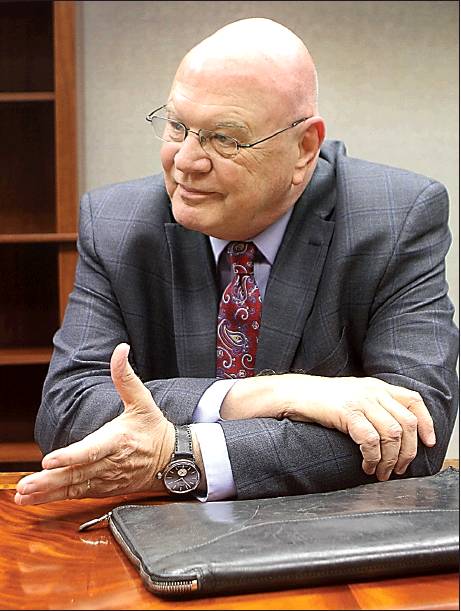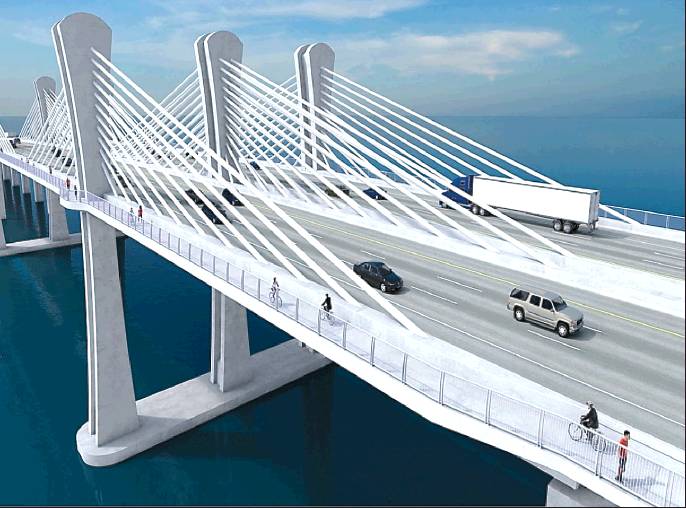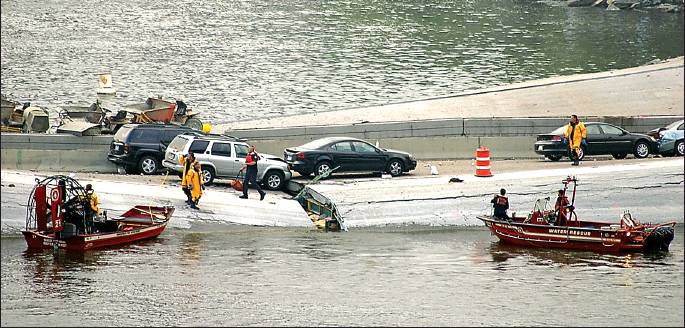‘WE’VE HAD ENOUGH’
Task force elaborates on proposal to finally get a new I-10 bridge built
By Crystal Stevenson
cstevenson@americanpress.com
Replacing the Interstate 10-Calcasieu River Bridge has not been a priority for the state, SWLA Economic Development Alliance President and CEO George Swift said, “and we’ve had enough.”
Swift said a blue ribbon task force formed about 15 months ago will be making a recommendation to the state on how it can replace the critical interstate bridge without incurring debt or using tax revenue.
“We’ve been told we don’t have the state money, we don’t have any federal money, and with the increased traffic on an unsafe bridge ... this is a way to get the project done,” Swift said. “It’s going to take a change in mindset for the state to go along with it, but doing nothing is really not a good option.”
Keith DeRousseau, chairman of the task force, said the group interviewed transportation-related governmental bodies along the Gulf Coast to learn about their strategies and obstacles in replacing similar infrastructure.
“We were able to learn from the groups how to overcome our fiscal restraints and the different delivery methods available, and that’s what brought us to our recommendation of the innovative P3 (public-private partnership) plan,” DeRousseau said. “It’s a proven, common-sense solution for this project.”
The recommendation for the design calls for a new six-lane bridge with shoulders and a pedestrian walkway, located immediately north of, and parallel to, the existing bridge with entrance and exit ramps into Westlake over the railway.
The current bridge would remain open while construction of the new bridge takes place. DeRousseau said through the partnership, the bridge would be constructed and the builder would be repaid through the use of electronic tolling “like we see in Houston and many other cities across the country.”
The state Department of Transportation and Development has estimated it would cost $800 million to replace the bridge.
Their plans, however, do not include entrance and exit ramps into Westlake, DeRousseau said.
“And this proposal costs less,” he said. “Our estimates are between $400-$600 million.”
Task force member John Pohorelsky said the I-10 bridge has been rated a 6.6 out of a 100 by the National Bridge Registry, which “suggests we are at the end of the life of the bridge.”
“We’ve all read the negatives of no tolls because we pay taxes for this, but the reality of the situation is that the process to replace this bridge started about 30 years ago,” Pohorelsky said. “We’ve all been paying taxes over that period of time and not one tax dollar has gone to the replacement of the bridge.”
Pohorelsky said the task force also used the Louisiana Freedom of Information Act to obtain records that prove contamination fears from a toxic chemical spilled in the Calcasieu River in the 1990s “are not a cause for a delay.”
“They recognized almost 10 years ago that we could deal with that, we could build over it and not impact our aquifer,” Pohorelsky said. “Plus technology now allows us to expand across the river without using pilings to support the structure. If there is an area of concern, even if they were to find it during construction, technology now would allow us to cross it without impacting it.”
The task force said tolls would be reduced for local residents.
“We know we’re going to have several companies interested in doing this project, and the competition is going to drive price down,” Pohorelsky said. “Frankly I’m hopeful companies offer lower tolls than we’re anticipating simply because if they are given an opportunity to build this bridge and set a standard for the nation, it opens the door for other infrastructure projects like this.”
DeRousseau said when the bridge is paid for, the tolls will continue for future maintenance issues.
“As long as you’re operating the bridge, you’re always going to have maintenance costs associated with it,” he said. “Let’s not put the burden back on the state’s books again and wonder if we have the money in the future to pay for it.”
The private developer would remain the operator of the bridge under contract with DOTD, who would continue to conduct inspections on the infrastructure. If repairs are needed, the developer would pay for that work through the tolls collected.
The federal government would have to approve the toll and delivery method, DeRousseau said.
“We’ve heard every excuse imaginable from the state as to why it can’t be done, the task force has come up with a way to get it done within a reasonable amount of time,” Swift said. “We’ve got a plan, no one has an another alternative. Nobody wants to pay a toll, but it’s a way to get the thing done.”
Pohorelsky said if something is not done, eventually the bridge could be taken out of service.
“If there is a failure, and the bridge is taken out of service, our alternative is I-210 and that bridge right now is down to two lanes,” he said. “No toll means the potential for a real economic catastrophe, not to mention the loss of life if there were people on the bridge if there was a failure. It doesn’t even have to be a failure, just the bridge closing would be catastrophic because our area would die economically from the congestion.”
DeRousseau said the Interstate 35 West Mississippi River bridge that collapsed in Minneapolis in 2007 was rated a 50 out of 100.
“It was a structural steel bridge also, similar to what we have, and located in a coastal area,” he said. “Ours is a 6.6 and theirs collapsed at 50.”
Task force member Bart Yakupzack said the next step for the group is to meet with DOTD, which will have to approve of the design and issue a request for proposal through a bidding process.
If everything is approved, construction — which is expected to take three years — is forecast to start in August of 2020.
“In this next 365 days we’ve got this crisis of congestion with I-210 down to two lanes,” Yakupzack said. “To say right now I’m against a toll is to say I’m OK with that substandard piece of infrastructure for the next decade.”




